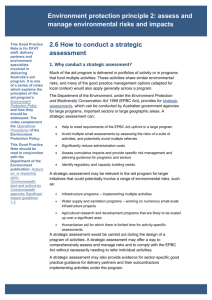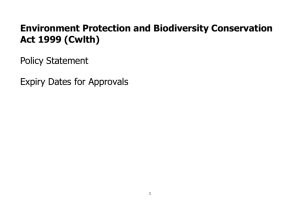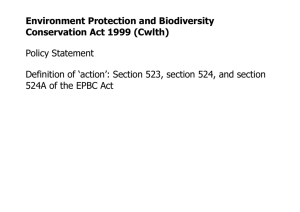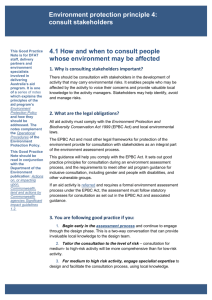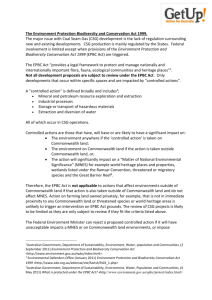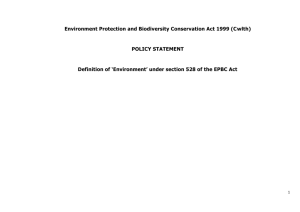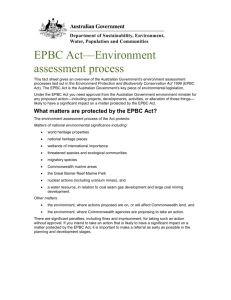Explainer: one-stop-shop for environmental approvals
advertisement
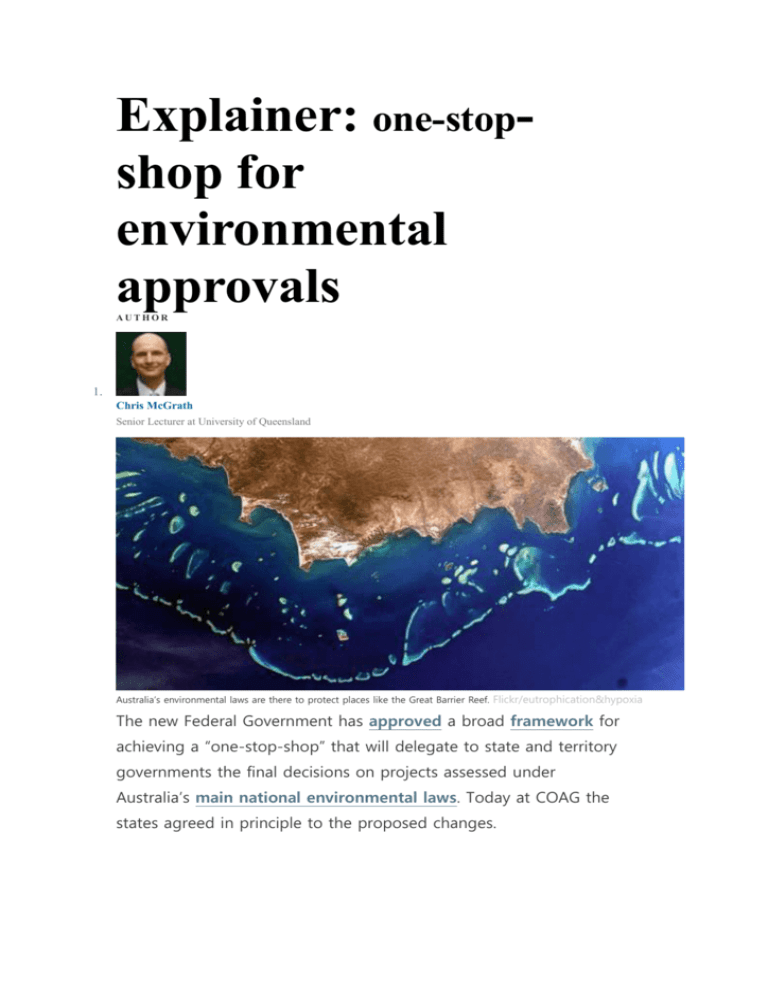
Explainer: one-stopshop for environmental approvals AUTHOR 1. Chris McGrath Senior Lecturer at University of Queensland Australia’s environmental laws are there to protect places like the Great Barrier Reef. Flickr/eutrophication&hypoxia The new Federal Government has approved a broad framework for achieving a “one-stop-shop” that will delegate to state and territory governments the final decisions on projects assessed under Australia’s main national environmental laws. Today at COAG the states agreed in principle to the proposed changes. Federal Environment Minister Greg Hunt says that the “one-stop-shop will slash red tape and increase jobs and investment, whilst maintaining environmental standards.” The Business Council of Australia claims rather breathlessly that the agreement at today’s COAG meeting “is a long overdue breakthrough, which will begin the process of securing Australia’s massive investment pipeline, without lowering environmental standards”. Whether the claimed benefits are achievable is an open question and there are serious potential problems with the proposed system. In 2012 the former Gillard Government proposed a similar system but ultimately placed it on hold due to concerns it would create uncertainty and a patchwork regime across Australia. Possibly reflecting similar problems of creating a patchwork system, at this stage onlyQueensland and NSW have signed memorandums of understanding to work with the new Commonwealth Government for its “one-stop-shop”. Few details have yet been released, but what do we know about how the new process will work and how much more efficient will it be than the current system? How does the current system work? One of the major obstacles to creating a one-stop-shop for environmental approvals is that Australia’s federal system of government is more like a scrambled egg than a neatly layered cake. Within this scrambled egg relatively few day-to-day decisions about development that will affect the environment are made by the Commonwealth government. The vast bulk of decisions are made by local, state and territory governments. For instance, there are around 250,000 applications a year under state and territory planning laws, most of which are decided by local governments. In contrast, the main Commonwealth environmental law, the Environment Protection and Biodiversity Conservation Act 1999 (EPBC Act), deals with only around 400 referrals each year. The EPBC Act mainly regulates actions affecting World Heritage properties, listed threatened species, and other “matters of national environmental significance”. The projects that it regulates closely tend to be big projects. The EPBC Act approval process has three stages: referral, assessment and approval. At the referral stage the Commonwealth decides whether a proposed action triggers the Act and requires approval under it. This has proved to be a very efficient process of screening out many projects and providing certainty to proponents that their projects do not trigger the Act. On very rare occasions, projects have been refused as “clearly unacceptable” at this first stage, thereby avoiding further costs and delay in carrying out an assessment. Experience over the first decade of the Act’s operation showed that over 75% of projects referred under it were decided within weeks and dropped out under this first stage. This fact is normally omitted by individuals and organisations such as the Business Council of Australia, who rail against the costs and delays caused by EPBC Act. Only around 22% of referrals are determined to be controlled actions that proceed through the assessment and approval stages. For these actions the EPBC Act has mechanisms to avoid duplication with state and territory assessments known as “bilateral agreements”. There are two types of bilateral agreements. Assessment bilaterals allow state and territory assessment processes to be used under the EPBC Act but the final decision on whether to approve a project remains with the Federal Environment Minister. Assessment bilaterals have been in place with all states and territories for years and have proved to be effective in reducing unnecessary duplication and delay. In contrast, approval bilaterals delegate the final decision on a project to the state and territory government. While this mechanism has existed in the Act from the outset, it has been virtually unused. An example of how efficiently the existing assessment bilateral system works to avoid duplication or delay due to the EPBC Act is the Alpha Coal Mine. That project began its assessment under Queensland law in 2008 and has not yet been approved, despiteclaims to the contrary in 2012 by the Queensland Premier. The project was referred under the EPBC Act in 2009, assessed under the bilateral agreement and approved by the Commonwealth in 2012. The state approvals are unlikely to be granted before early to mid-2014. That is, state approval may come some 18 months after the Commonwealth approval. A rarely used but important safety net for the environment Under the existing system the EPBC Act has rarely stopped or significantly delayed a project. Yet some important decisions have been made under it, stopping highly damaging activities such as mass killing of flying foxes adjacent to the Wet Tropics World Heritage Area. One example where the EPBC Act has stopped a major project was the Traveston Crossing Dam in Queensland. This project also illustrates the most important role of the EPBC Act in practice – to provide an appropriate level of oversight on state government-sponsored projects. The Queensland Government proposed the dam in 2006 at the height of a major drought gripping the state. It assessed the project under state laws and concluded that the environmental impacts were acceptable. The old system worked well when Traveston was being considered. Patrick McCully The Federal Environment Minister at the time, Peter Garrett, requested independent experts to review the state assessment and they found major deficiencies in it regarding impacts on threatened species. His subsequent decision to refuse the dam based on that independent expert advice was an example of good decision-making under the EPBC Act, which prevented a project that would have caused serious damage to several threatened species. Had an approval bilateral been in place at the time when the dam was proposed, delegating the final EPBC Act decision on it to the state government, it is certain that the state would have approved the dam being built and severe impacts on threatened species would have occurred. What changes are proposed? The “one-stop-shop” policy proposes to enter approval bilateral agreements under the EPBC Act with all state and territory governments, thereby delegating final approval powers over projects to them. While the framework so far released to the public reads like a complete handover of all Commonwealth decisions to the states, the Federal Environment Minister qualified the Coalition’s policy before the election when he was the Coalition’s environment spokesperson. He said in an interview reported in the Weekend Australian in May 2013 that: “some matters would be reserved where the Commonwealth would be the one-stop-shop but overwhelmingly it would be the states." The Minister confirmed in a radio interview after the election that the Commonwealth will retain control over decisions involving offshore Commonwealth waters, nuclear actions, and projects for which state governments are “likely to have a significant conflict of interest” as the proponent. Assuming these promises are fulfilled, they alleviate the most significant concernabout the one-stop-shop policy: where the state is the proponent they’ll have difficulty making an independent assessment. The Saraji coal mine in Queensland Lock the Gate Alliance/Flickr What are the likely savings in time and money? Peering behind the political rhetoric, it is difficult to see how the “onestop-shop” policywill “slash red tape and increase jobs and investment, whilst maintaining environmental standards”. Under the policy there is no intention to repeal the EPBC Act or reduce the range of projects to which it applies. Only the final decision-maker will change. For proponents, most of the costs and delay comes in the environmental impact stage. There are already assessment bilaterals avoiding duplication of state and federal governments this stage. Given this, it is difficult to see where significant time and costs savings will be achieved by the policy. Another reality check for the “one-stop-shop” slogan is that it will only apply to projects that require both federal and state approval. There is no intention to apply federal laws to all projects. This means that even after the policy is implemented there will still be at least two “shops”: one for the relatively few projects assessed at federal and state levels, and another for the vast bulk of projects assessed only at a state or local government level. The claims made of the benefits of the “one-stop-shop” therefore appear to be largely political hyperbole.



